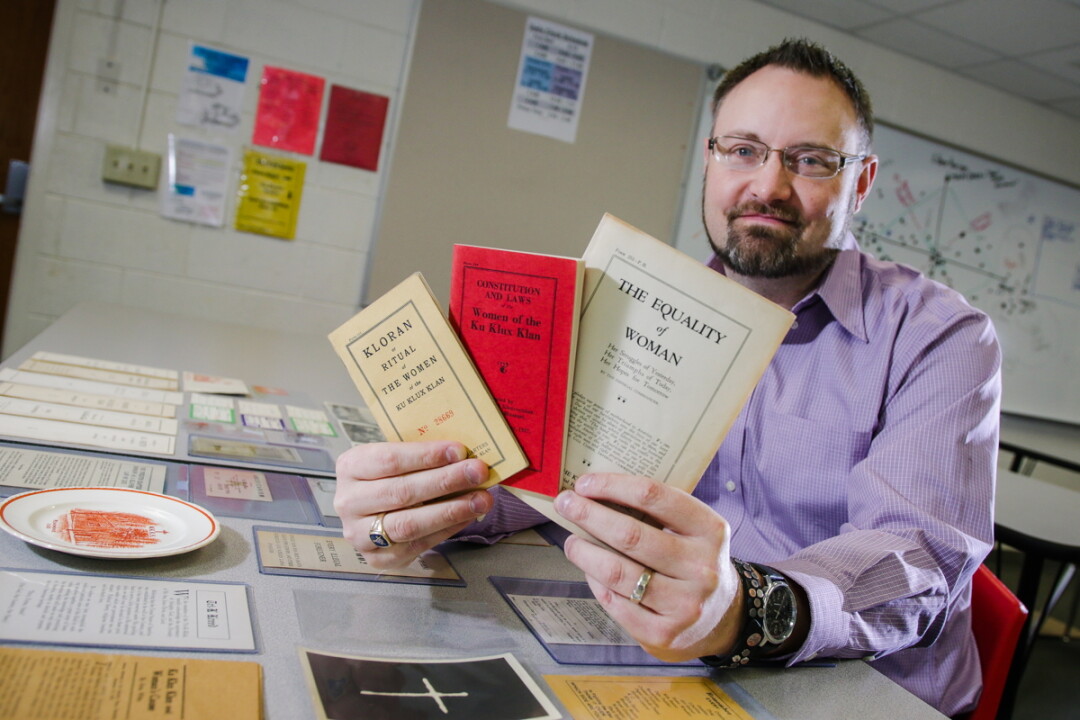Terribly Close to Home
book details women’s KKK history in Chippewa Falls
Briana Novacek, photos by Andrea Paulseth |

John E. Kinville was apprehensive while writing his book.
“There was a part of me thinking, ‘Do I really want myself associated with the Ku Klux Klan for the rest of my life?’ ” he said. Kinville’s book, The Grey Eagles of Chippewa Falls – A Hidden History of a Women’s Klu Klux Klan in Wisconsin, delves deep into the story of a group of women Klan members in Chippewa Falls.
Kinville has been teaching at Chippewa Falls High School for 16 years, and currently teaches American government. “I view every kid as being a very important part of not just our community, but our country,” Kinville said. He earned his bachelor’s in broadfield social studies education at UW-Eau Claire and his master’s degree in history education at UW-River Falls. This is Kinville’s first published book, but now that it’s finished, he says he has ideas for another book in the works.
Kinville discovered records of the Grey Eagles during his studies at UW-Eau Claire, where they were housed in the campus Special Collections Department. There were business meeting minutes, membership rosters, and miscellaneous documents and ephemera from the Women’s Klu Klux Klan of Chippewa Falls.
“It just captivated me, it sucked me in,” Kinville said. “I always told myself that someday, if nobody else does, I’m gonna come back to this, I’m gonna write a book.” He pursued other things, finishing his education and beginning his teaching career. After several years had gone by, Kinville decided it was time to write.
Historians categorize the KKK’s influence into three separate phases, the first beginning during the Civil War and the third still in existence today. Kinville’s book focuses on the second Klan, which was strongest in the 1920s.
“The goal was to transform the Klan from a regional Georgia fraternity to a national powerhouse,” Kinville said. To accomplish this, Klan leaders strategically marketed the Klan to each region’s xenophobic tendencies, whether that be fear of Catholics, immigrants, alcohol supporters, Jews, blacks, labor unions, criminals – any group that they determined was of low moral character.
“It really goes back to the initial marketing strategy of, ‘We’re going to find who you’re scared of and we’re going to make that the centerpiece of the sales pitch,’ ” Kinville said. In Chippewa Falls, the Klan focused its attention on opposing Catholics and upholding Prohibition.
Kinville’s book centers on female involvement in the Klan, the WKKK. The Chippewa Falls branch was called the Grey Eagles, “in reference to their median age of 43.5 years old.” The issues that they focused on were “the continuation of Prohibition, the importance of strong public schools, and the prevention of Democratic presidential candidate Al Smith, a Catholic, from reaching the White House in 1928,” according to Kinville. The WKKK claimed to provide white Protestant women with an opportunity to advance their social, political, and economic standing, with a national membership of 500,000 at its peak. KKK members in the 1920s and 1930s were average citizens of their communities, holding jobs and raising families.
Kinville conducted interviews during the research process with relatives of former Klan members. Most were grandchildren of Klanswomen and had no idea that the grandmothers they had looked up to had a dark past.
“The people that have been the most supportive of my efforts have been the relatives,” Kinville said. He has been very up-front with the families, which helped ease their apprehension toward his book. As the families process the news, “there’s that rollercoaster of emotions that has to be gone through,” Kinville added.
 Nowadays, sentiments have changed and it seems unthinkable that the Klan met in buildings right here in the Chippewa Valley. The first cross burning by the KKK in Chippewa Falls was on the hill behind Leinenkugel’s Brewery, now the newer part of Forest Hill Cemetery, Kinville said. The Klan met in what is now the Metropolitan Block building in downtown Chippewa Falls. Imagining such a volatile organization meeting so close to home is sobering.
Nowadays, sentiments have changed and it seems unthinkable that the Klan met in buildings right here in the Chippewa Valley. The first cross burning by the KKK in Chippewa Falls was on the hill behind Leinenkugel’s Brewery, now the newer part of Forest Hill Cemetery, Kinville said. The Klan met in what is now the Metropolitan Block building in downtown Chippewa Falls. Imagining such a volatile organization meeting so close to home is sobering.
The book launch for The Grey Eagles of Chippewa Falls – A Hidden History of a Women’s Ku Klux Klan in Wisconsin, will take place at 6pm Monday, Feb. 17, at the Heyde Center (3 S. High St., Chippewa Falls). The event is free to attend, and books will be available for $20. Kinville will also promote the book at an event at 6pm Thursday, March 12, at the Volume One Gallery (205 N. Dewey St., Eau Claire).


















